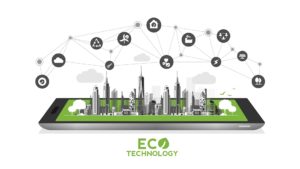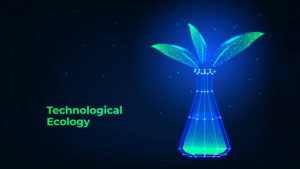Environmental Technology is becoming a major factor in the world’s transition to sustainability. Fresh technologies are emerging to tackle the global issues of climate change, resource depletion, and environmental degradation. These technologies are intended to lessen human impact on the environment while simultaneously improving resource efficiency and nurturing a more sustainable future.
Nonetheless, the use of present-day science and technology to protect, monitor, and enhance the environment is known as environmental technology. It covers inventions meant to lessen the consequences of climate change, conserve resources, and cut down on pollution. These technologies include cutting-edge devices that help in water recycling or trash reduction, as well as renewable energy sources like solar and wind power.
Environmental Technology, sometimes called “green” or “clean” technology, aims to develop new technology solutions that lessen the negative impacts of industries and human activity on the environment. The development of innovative goods and systems with the goals of reducing pollution, conserving natural resources, and tracking changes in the environment to stop future deterioration is a priority.
Furthermore, Technology and industrial operations have historically had a detrimental effect on the environment, worsening problems like deforestation, air and water pollution, and the depletion of non-renewable resources. The acceleration of issues such as biodiversity loss and global warming due to this harm makes it vital to identify technology solutions and Environmental Technology verification that counteract or lessen these consequences.
Global awareness of environmental challenges, especially climate change, has increased recently, though. Governments, corporations, and communities have been compelled by this concern to create and implement environmentally conscious technologies that prioritize sustainability.
Not only technologies but every aspect should also be done sensibly. These innovations are meant to lower carbon emissions, increase energy economy, and encourage resource conservation.
The ultimate objective of this tech is to move civilization toward a low-carbon, sustainable economy. Therefore, creating strategies to satisfy current energy and resource demands without endangering the capacity of future generations to satisfy their own is important and needs time. Long-term planet health can be ensured by reducing our ecological footprint through the utilization of clean and efficient technology services. Being responsible toward the planet at the individual and general levels is both a need of time.
The Connection between Sustainability and Environmental Technology

The ability to meet present-day requirements without compromising the ability of future generations to meet their own needs is known as sustainability. By creating solutions that reduce our environmental impact while preserving social and economic well-being, Environmental Technology plays a critical role in striking this balance.
The following are some important areas where Environmental Technology supports sustainability:
Cutting Carbon Emissions: The carbon footprint can be reduced with the use of technologies like electric cars (EVs) and renewable energy sources.
Resource Efficiency: We use resources more responsibly due to developments in recycling, water purification, and sustainable agriculture.
Pollution Reduction: By cleaning up the air, soil, and water, cutting-edge technology improves the health of our ecosystems.
Energy Efficiency: We use less energy due to smart grids, energy-efficient appliances, and construction materials.
Societies can advance and prosper while preserving natural ecosystems for future generations by making use of these technologies.
The Top 10 Environmental Technology Innovations for Sustainability

The drive toward sustainability is undergoing a radical change because of environmental technologies. While only a small portion of the advancements are being achieved, these top 10 Environmental technology inventions show how science and technology are offering practical answers to some of the most important environmental problems facing the globe. As these technologies advance, they will not only lessen our influence on the environment but also open the door to a day when ecological balance and human development coexist together.
Now let’s explore some of the most significant advancements in Environmental Technology that are assisting in the transition to a more sustainable future:
-
Developments in Solar Power
For many years, solar energy has been a major participant in the renewable energy market. More recently, solar panels have become more affordable, more effective, and even flexible or transparent, making it possible to mount them on curved surfaces like windows. Large-scale communities and enterprises can now be powered by Environmental technology solar groups and improved battery storage.
-
Innovations in Wind Energy
Technology for wind energy has also advanced significantly. In deeper waters with stronger and more constant winds, modern floating wind generators can be installed. Wind power technology services are also less disturbing and cleaner because bladeless wind turbines are more silent and friendly to birds.
-
Hydrogen and Electric Automobiles
A significant portion of carbon emissions come from the transportation sector, but EVs and hydrogen-powered cars are transforming this market. Hydrogen-powered cars only release water vapor, but electric vehicles (EVs) are getting cheaper and have greater ranges. Making the switch to greener automobiles is becoming simpler due to advancements in battery technology solutions and the growth of the charging infrastructure.

-
Energy Storage and Smart Grids
Smart grids are electrical networks that efficiently manage electricity production, distribution, and consumption through the use of digital technology solutions. Smart grids can guarantee that energy is used more effectively by incorporating renewable energy sources like solar and wind. Furthermore, advances in technology services like energy storage (such as sophisticated lithium-ion and solid-state batteries) make it possible to store extra energy for usage at peak energy hours or in the absence of power from renewable sources.
-
Energy-from-Waste Systems
Waste-to-energy technologies transform non-recyclable waste materials into usable energy, preventing garbage from piling up in landfills. With this Environmental technology innovation, waste management problems for cities and enterprises can be solved while producing power or heat and reducing the amount of waste produced.
-
Sustainable Agriculture and Vertical Farming
Vertical farming provides a more sustainable alternative to traditional farming techniques, which can deplete soil and water supplies. Vertical farms, which can be constructed in urban areas and use up to 95% less water by growing crops in stacked layers using hydroponics or aeroponics, lower transportation emissions. Food production is changing as a result of this Environmental Technology verification; which also conserves water and land.
-
Desalination and Water Purification
Concern over access to clean water is growing, although advances in technology services like desalination and water purification are addressing this issue. While nanotechnology filters can remove toxins from freshwater sources, improving the safety of drinking water, reverse osmosis and solar desalination technologies are making it possible to convert seawater into drinking water more effectively.

-
Carbon Capture and Storage (CCS)
With the application of Environmental technology, carbon dioxide emissions from industrial activities can be captured and stored underground or put to different uses. By lowering the quantity of CO2 released into the atmosphere, this technique helps to mitigate the consequences of climate change.
-
Compostable Substances
One of the biggest environmental issues we have is plastic garbage. However, new plant-based ingredients are increasingly being used to create biodegradable plastics. These environmentally friendly materials can drastically lessen the load on landfills and oceans since they decompose more quickly than conventional plastics.
-
Smart Houses and Structures
Energy efficiency in houses is increasing due to smart home technology solutions, and technology services. These solutions cut energy use and utility costs, from LED lighting and energy-efficient appliances to smart thermostats that modify heating and cooling based on occupancy. The environmental effect of a building can be further decreased by using renewable energy sources and sustainable materials in the design of green buildings.
Environmental technology is one of the impactful and highly needed advancements in the modern age where environmental and climatic issues are at their peak.













